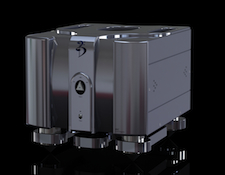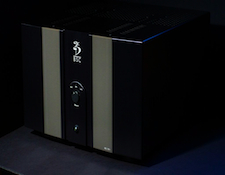It’s the time of year for saving money!
 To any audiophile the name D’Agostino is highly recognizable and one that means quality equipment and innovative products. I recently had the pleasure of interviewing Bret D’Agostino, the oldest son of the renowned designer Dan D’Agostino. Bret’s company, BSC Audio is a manufacturer of Class A amplifiers and soon to be preamps.
To any audiophile the name D’Agostino is highly recognizable and one that means quality equipment and innovative products. I recently had the pleasure of interviewing Bret D’Agostino, the oldest son of the renowned designer Dan D’Agostino. Bret’s company, BSC Audio is a manufacturer of Class A amplifiers and soon to be preamps.
Bret cut his teeth in audio working alongside his Father at Krell, the company Dan helped found. In the 2009 time frame both Dan and Bret left Krell and shortly after formed Dan D’Agostino Master Audio Systems. This was borne by a concept of what Dan and Bret liked about audio and what they did not. This collaboration led to the smaller, more compact and visually elegant Momentum Amplifier that now carries the Dan D’Agostino name. However, eventually Bret came to feel like the time was right to strike out on his own. As he puts it “I was forty one or forty two years old and I felt like if I was going to do something on my own this was probably the right time to do it.”
His decision to go on his own also included his desire to create a product that as he puts it “brought the magic back into audio.” Accomplishing this was a clear path for Bret. He would start by developing a line of Class A amps. “I’ve heard thousands and thousands of audio systems in my life and there were a handful that really stood out for me. And most of those systems were composed of big, Class A amplifiers.” He added “those systems, for some reason, were the ones that imprinted a very specific presentation in my soul.” Once this decision had been made, Bret, and BSC Audio were moving forward.
Bret also realized that while Class A amps have long been known for their remarkable sound, there were also design compromises. Large physical size, high heat output and high current draw were chief among these compromises.
“Unfortunately, with Class A, there’s no way really to get around heat” was his response to my question regarding operating temperature. In order to address the subject he looked at the cause of heat in Class A. “External heat sinks, are to me a nightmare” was the first obstacle to consider. In addition to causing as he put it, “painful scars” from moving amps with external heat sinks, they also outwardly radiate an “amazing amount of heat.” Bret’s solution was to optimize his own heat sinks and move them inside the enclosure. He then designed a “massive output stage I could fit between the heat sinks.” This allowed the overall enclosure size to be somewhat smaller but not compromise the overall cooling of the circuits.
HIs next area of interest was the bias itself. He told me “I remembered for many years people had switches on their amplifiers for Class A and Class AB. I also remembered that when you pressed that button there was almost no difference in sound.”
 Bret’s design philosophy is to have a product tailored to the task. For instance, he believes that for most home theater Class A is not required. So for those types of applications he noted “I thought it would be interesting to just turn the bias down to where the distortion characteristics of the output stage are within reason.” Again, drawing from his past, he reasoned “what if I made it, like 25%, 50%, 75% and a 100% Class A.” After some trial and error he settled on what he calls an “ECO mode, which pretty much takes 90% of Class A out of the circuit.” This allows the amp to have a wonderful sound and yet stay relatively cool to the touch.
Bret’s design philosophy is to have a product tailored to the task. For instance, he believes that for most home theater Class A is not required. So for those types of applications he noted “I thought it would be interesting to just turn the bias down to where the distortion characteristics of the output stage are within reason.” Again, drawing from his past, he reasoned “what if I made it, like 25%, 50%, 75% and a 100% Class A.” After some trial and error he settled on what he calls an “ECO mode, which pretty much takes 90% of Class A out of the circuit.” This allows the amp to have a wonderful sound and yet stay relatively cool to the touch.
He also incorporated a 50% mode that allows for activities such as casual listening, a dinner party or any function where dedicated listening is not the main objective. In this mode “it does throw off heat but it is not nearly as much as when it is in full Class A.” In the 50% mode, the sound is better than when operating in ECO mode. In full Class A there is heat but it is “basically funneled upwards and there is very little heat on the sides and the back.” And in full Class A the sound qualities that Bret so desires are delivered to their full potential. Another benefit this configuration provides, in addition to managing the heat, is to reduce the power consumption. “Again, that is why it makes so much sense to have access to the bias control on the front of the amplifier and have it be a prominent feature.” He called a Class A amplifier that can be energy efficient an oxymoron. But in very literal terms the bias switch on the front of the enclosure allows that to take place. The power consumption in the standby mode is very minimal- actually less than 2 watts. Hardly what is typical for a traditional Class A amplifier. This allows the amp to be rather user friendly when not in use.
]]>Despite having an economy mode Bret told me “I didn’t want to compromise either. I think compromise needs to happen in any design of a product. I wanted to make sure that when you turn it up to 100% bias that this was an amplifier or a product that could compete with the best of them and there was no compromise in any way.” His guiding principal was that he wanted to design a product that could live up to the D’Agostino last name.
 When sourcing component parts Bret told me he is very selective. “I use all military grade or better components.” His goal is to provide a product that will live for twenty or thirty years. His design criteria are to basically “overbuild and build things in a way that if it does fail it can be easily serviced.” He therefore selects parts and designs circuits that operate at the lower end of the design threshold to allow for long life. All of his component parts are through-hole and rated to 105 Degrees Celsius to assure longevity. His design philosophy is rather simple: “You have to, a lot of times, use more parts in parallel to achieve the type of power ratings that you want for the circuit when you’re designing with surface-mount parts. And I believe that more parts are not the harbinger of better sound. I do think that minimal designs, where applicable make the most amount of sense. And the least amount of parts you can have in the signal path from A to B, technically, is ideal. But when you come into real world conditions of handling signals, noise and distortion levels, you tend to have to add some gain stages or different circuitry to handle complex things. In my opinion you certainly don’t need a really high part density to do that.” Mostly this is a philosophical outlook. Bret readily admits this is easier to hear than it is to measure.
When sourcing component parts Bret told me he is very selective. “I use all military grade or better components.” His goal is to provide a product that will live for twenty or thirty years. His design criteria are to basically “overbuild and build things in a way that if it does fail it can be easily serviced.” He therefore selects parts and designs circuits that operate at the lower end of the design threshold to allow for long life. All of his component parts are through-hole and rated to 105 Degrees Celsius to assure longevity. His design philosophy is rather simple: “You have to, a lot of times, use more parts in parallel to achieve the type of power ratings that you want for the circuit when you’re designing with surface-mount parts. And I believe that more parts are not the harbinger of better sound. I do think that minimal designs, where applicable make the most amount of sense. And the least amount of parts you can have in the signal path from A to B, technically, is ideal. But when you come into real world conditions of handling signals, noise and distortion levels, you tend to have to add some gain stages or different circuitry to handle complex things. In my opinion you certainly don’t need a really high part density to do that.” Mostly this is a philosophical outlook. Bret readily admits this is easier to hear than it is to measure.
As for new products along with the S5 stereo and the M5 monaural amplifiers, Bret is introducing a new L5 preamp at the Consumer Electronics Show at the Venetian in 2014. He is currently gearing up to begin shipping preamplifiers in February. He also has an integrated amp in the design phase. Currently, he has “50% of a design for the integrated that is somewhere in my CAD programs and in my brain.” His goal is to introduce the integrated amp at the Hong Kong show in 2014. It will also have a Class A architecture and will take design cues from the 5 Series amplifiers and also the L5 preamp.
Bret is also trying to keep the pricing on his products as low as possible. Despite predominately sourcing his components in the USA and doing all of his design, machining and assembly, domestically, his goal is to keep the cost at a reasonable level. He told me that he carefully looks at tooling and developmental costs and tries to absorb as much as, if not all of those costs so the consumer price will not be overtly prohibitive. He noted that not doing so “creates a price chasm that is too great.” His goal is to make the cost to performance ratio as acceptable as possible yet still perform to his exceptionally high standards. His S5 Stereo amp retails for $15,000.00, which is a very reasonable price point for an amp of this quality and compared to competing equipment.
Being the son of Dan D’Agostino I was naturally curious what has happened to the family dynamic. I asked Bret a very simple question- how does being a competitor to your Dad work? He noted, “We are not competitors. It’s very funny; in fact I’m showing with Dan this year at CES. It’s one of those situations, why don’t we show together this year?” He admitted that he has an unspoken Father and Son thing. He also believes that he and his Dad represent very different segments of the market. “My Father is a very brilliant designer,” he told me. However, Bret wanted to build something that was different from his Father’s and other designer’s products.
I had the opportunity to hear in person the BSC Audio S5 Stereo Amplifier at a private showing at a local dealer. I can say that visually, the amp is quite stunning. With the graceful, machined front the design is quite contemporary. Bret has also paid attention to the details. While the “B” on the front of the amp is illuminated Blue, it can also be dimmed or turned off completely to fit in with differing ambient lighting situations.
Sound wise, it is a very muscular, powerful amp. With a lot of headroom, this is an amp that will have little problem with virtually any speaker one wishes to pair it with. The system in which I heard it consisted of a Mac Book Pro with J River software as a source, a Berkley Audio DAC and a pair of Magico S1 speakers. The S5 amp performed up to Bret’s expectations in every way and sounded positively wonderful. Those who have not experienced the sonic attributes of a Class A amplifier should audition the S5. In my opinion it really sounded spectacular.
I would like to thank Bret D’Agostino for his time not only in hearing his amplifier but also for talking with me about his company and his products.





